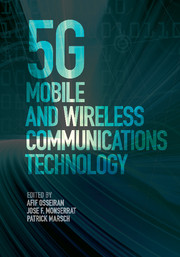Book contents
- Frontmatter
- Dedication
- Contents
- List of contributors
- Foreword
- Acknowledgments
- Acronyms
- 1 Introduction
- 2 5G use cases and system concept
- 3 The 5G architecture
- 4 Machine-type communications
- 5 Device-to-device (D2D) communications
- 6 Millimeter wave communications
- 7 The 5G radio-access technologies
- 8 Massive multiple-input multiple-output (MIMO) systems
- 9 Coordinated multi-point transmission in 5G
- 10 Relaying and wireless network coding
- 11 Interference management, mobility management, and dynamic reconfiguration
- 12 Spectrum
- 13 The 5G wireless propagation channel models
- 14 Simulation methodology
- Index
- References
3 - The 5G architecture
Published online by Cambridge University Press: 05 June 2016
- Frontmatter
- Dedication
- Contents
- List of contributors
- Foreword
- Acknowledgments
- Acronyms
- 1 Introduction
- 2 5G use cases and system concept
- 3 The 5G architecture
- 4 Machine-type communications
- 5 Device-to-device (D2D) communications
- 6 Millimeter wave communications
- 7 The 5G radio-access technologies
- 8 Massive multiple-input multiple-output (MIMO) systems
- 9 Coordinated multi-point transmission in 5G
- 10 Relaying and wireless network coding
- 11 Interference management, mobility management, and dynamic reconfiguration
- 12 Spectrum
- 13 The 5G wireless propagation channel models
- 14 Simulation methodology
- Index
- References
Summary
Introduction
The design of a mobile network architecture aims at defining network elements (e.g. Base Stations [BSs], switches, routers, user devices) and their interaction in order to ensure a consistent system operation. This chapter discusses basic considerations and provides an overview of current research activities. Network architecture can be considered from different angles that are needed in order to fulfill objectives like integration of technical components into an overall system, proper interworking of multi-vendor equipment and efficient design of physical networks from cost and performance point of view.
As 5G systems have to integrate a plethora of partly contradicting requirements, enablers such as Network Function Virtualization (NFV) and Software Defined Networking (SDN) are to be applied in order to provide the needed flexibility of future networks, especially for the core network. Applying these tools may require a rethinking of some traditional aspects of network architecture design. This chapter will give the reader an impression of the most important topics influencing architecture design of future networks.
NFV and SDN
Today's operator networks include a large and increasing variety of hardware appliances. Launching new services often requires integration of complex hardware dedicated to the service including costly procedure design and is associated with lengthy time to market. On the other hand, hardware life cycles become shorter as technology and service innovation accelerates.
At the end of 2012, network operators have started an initiative on NFV [1]. NFV aims at consolidating the variety of network equipment onto industry-standard high-volume servers. These servers can be located at the different network nodes as well as end-user premises. In this context, NFV relies upon but differs from traditional server virtualization. Unlike server virtualization, Virtualized Network Functions (VNF) may consist of one or more virtual machines running different software and processes in order to replace custom hardware appliances (Figure 3.1). As a rule, multiple VNFs are to be used in sequence in order to provide meaningful services to the customer.
NFV requires an orchestration framework that enables proper instantiation, monitoring and operation of VNFs and Network Functions (NFs) (e.g. modulation, coding, multiple access, ciphering, etc.).
- Type
- Chapter
- Information
- 5G Mobile and Wireless Communications Technology , pp. 50 - 76Publisher: Cambridge University PressPrint publication year: 2016



